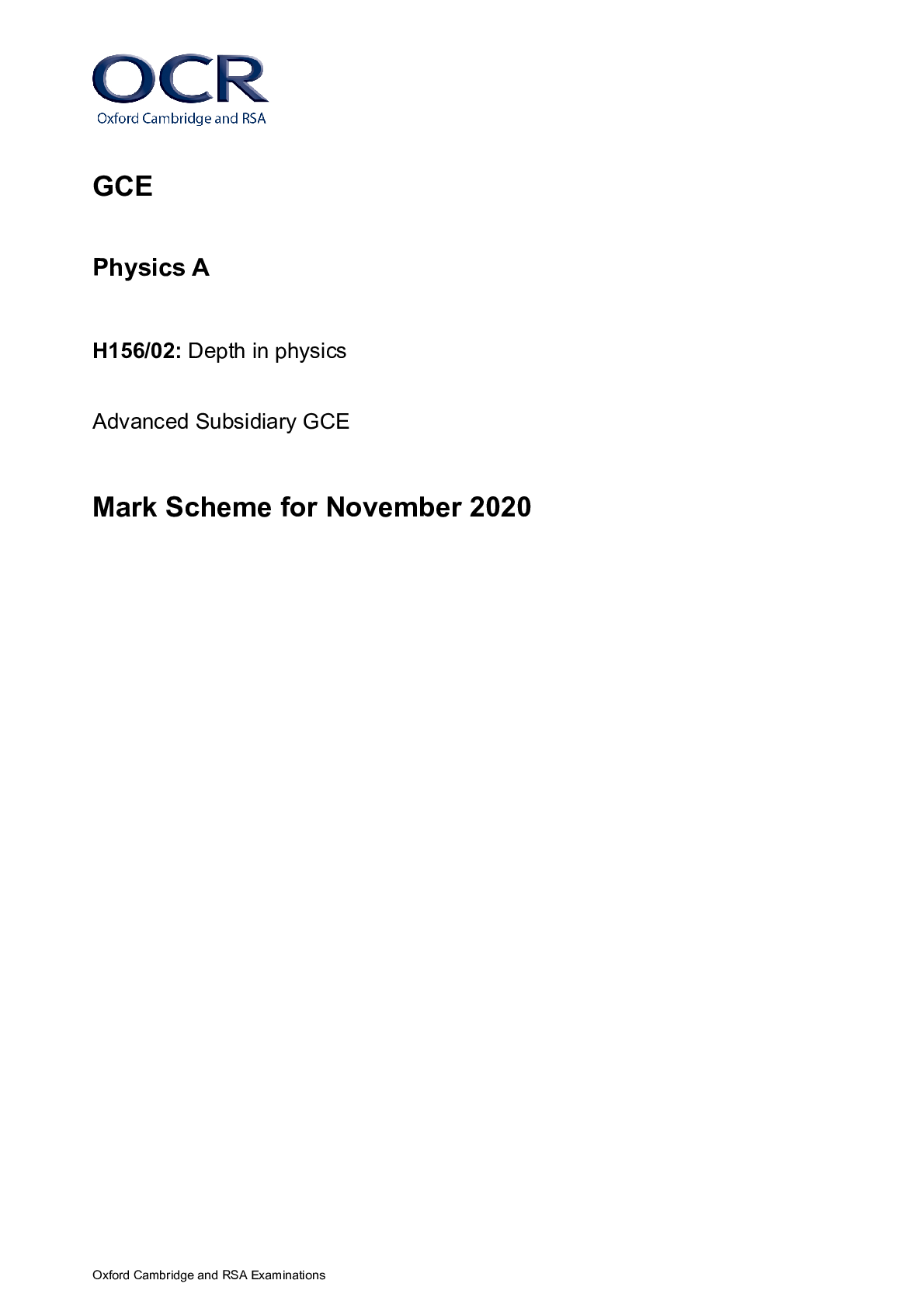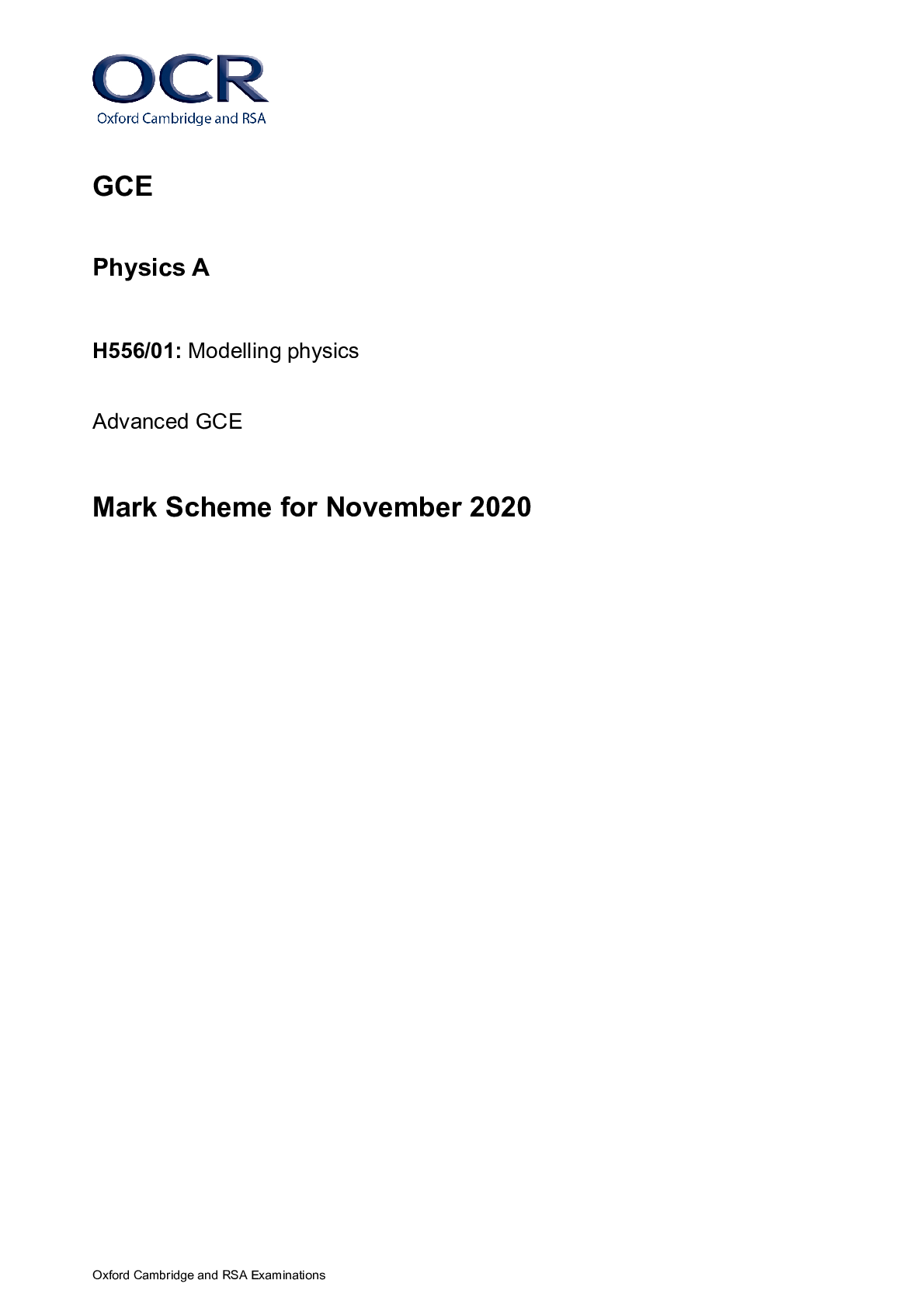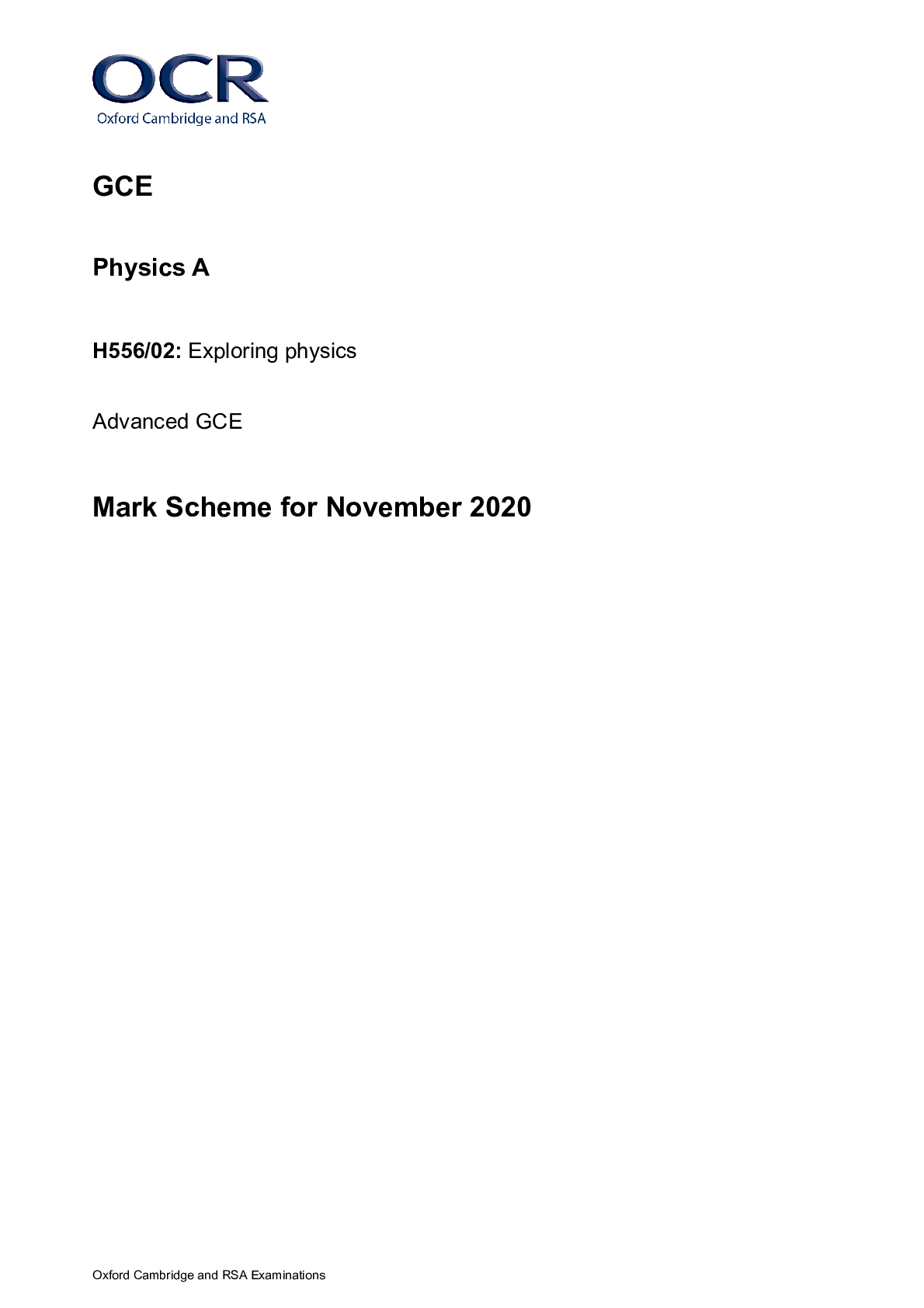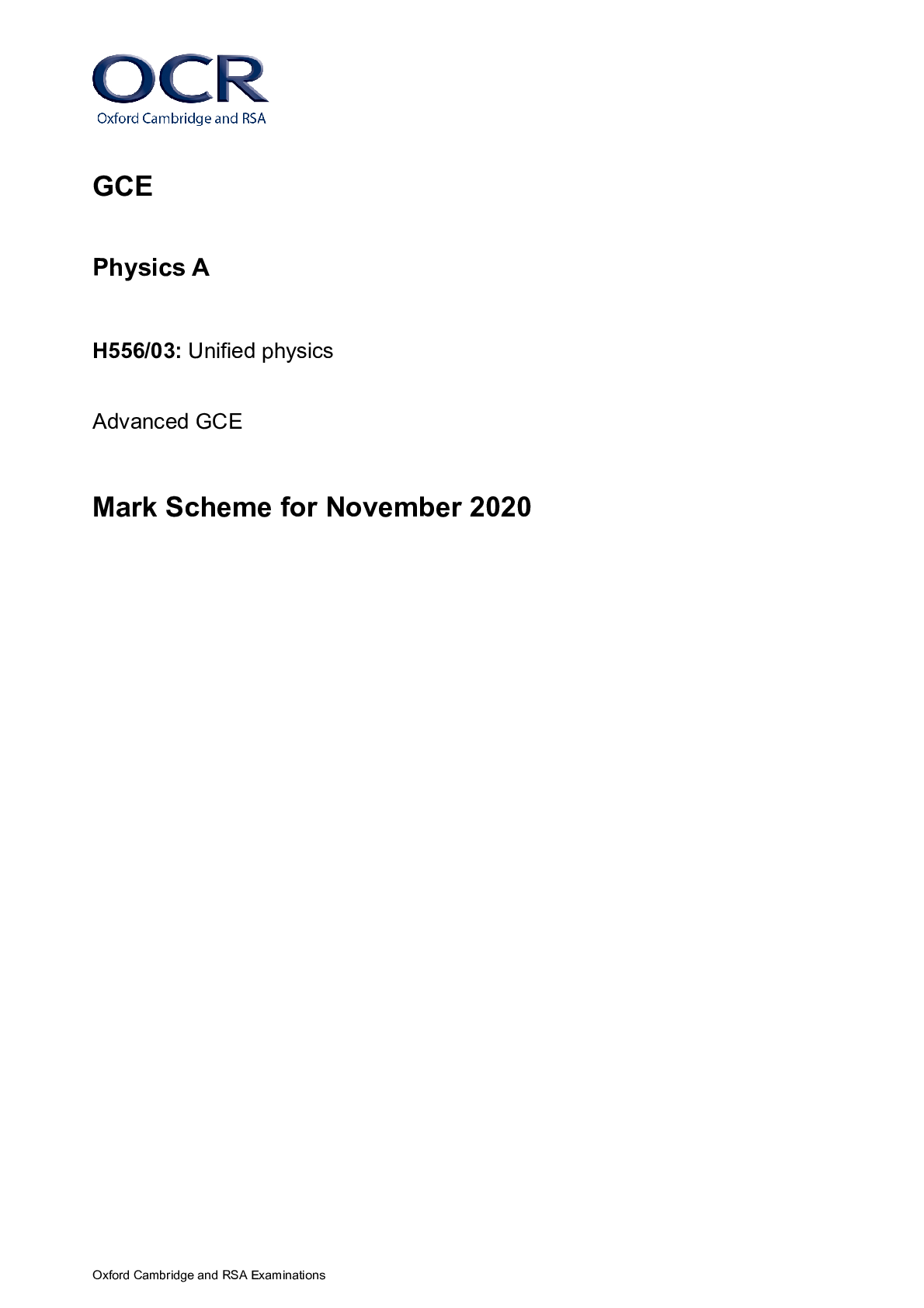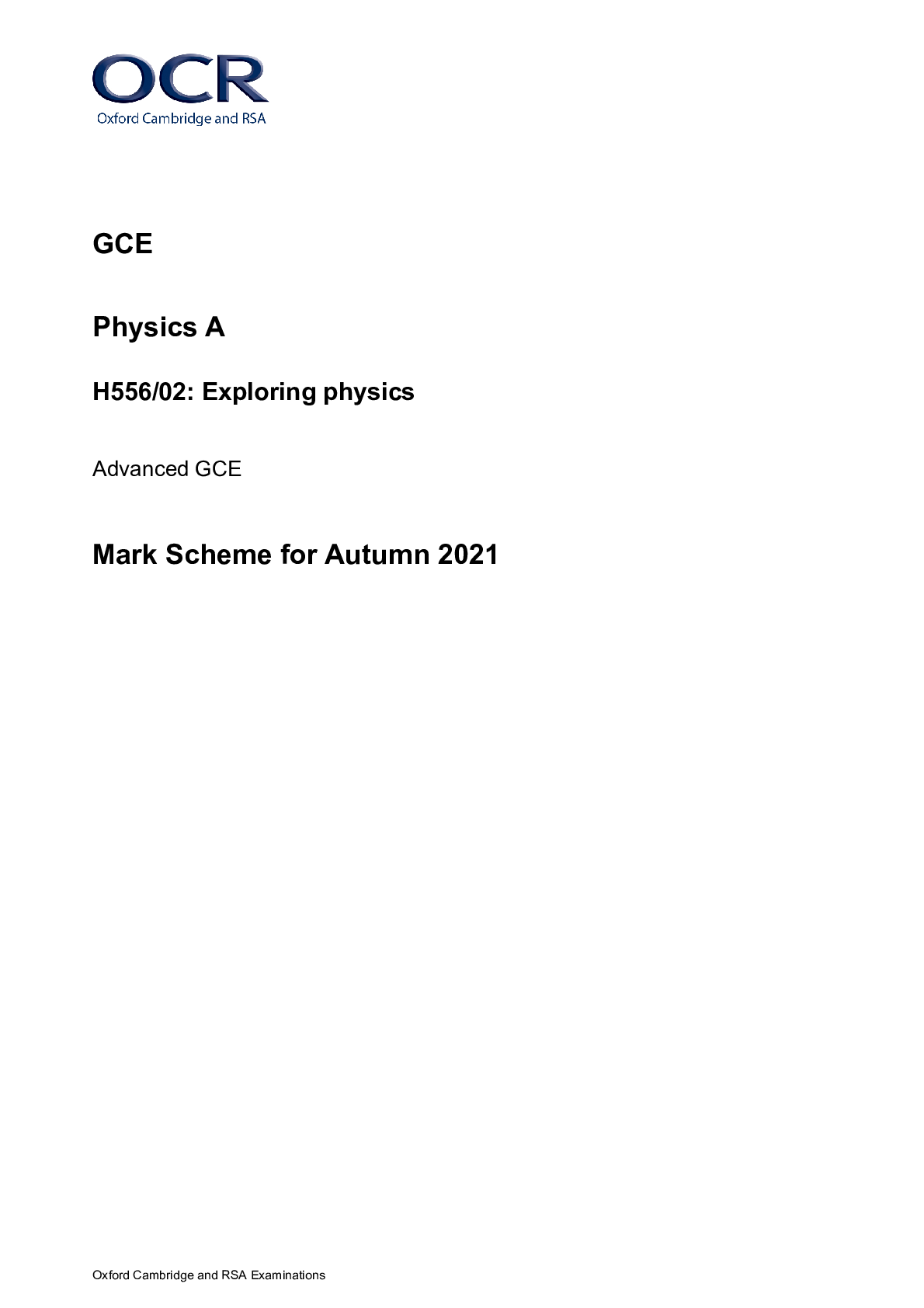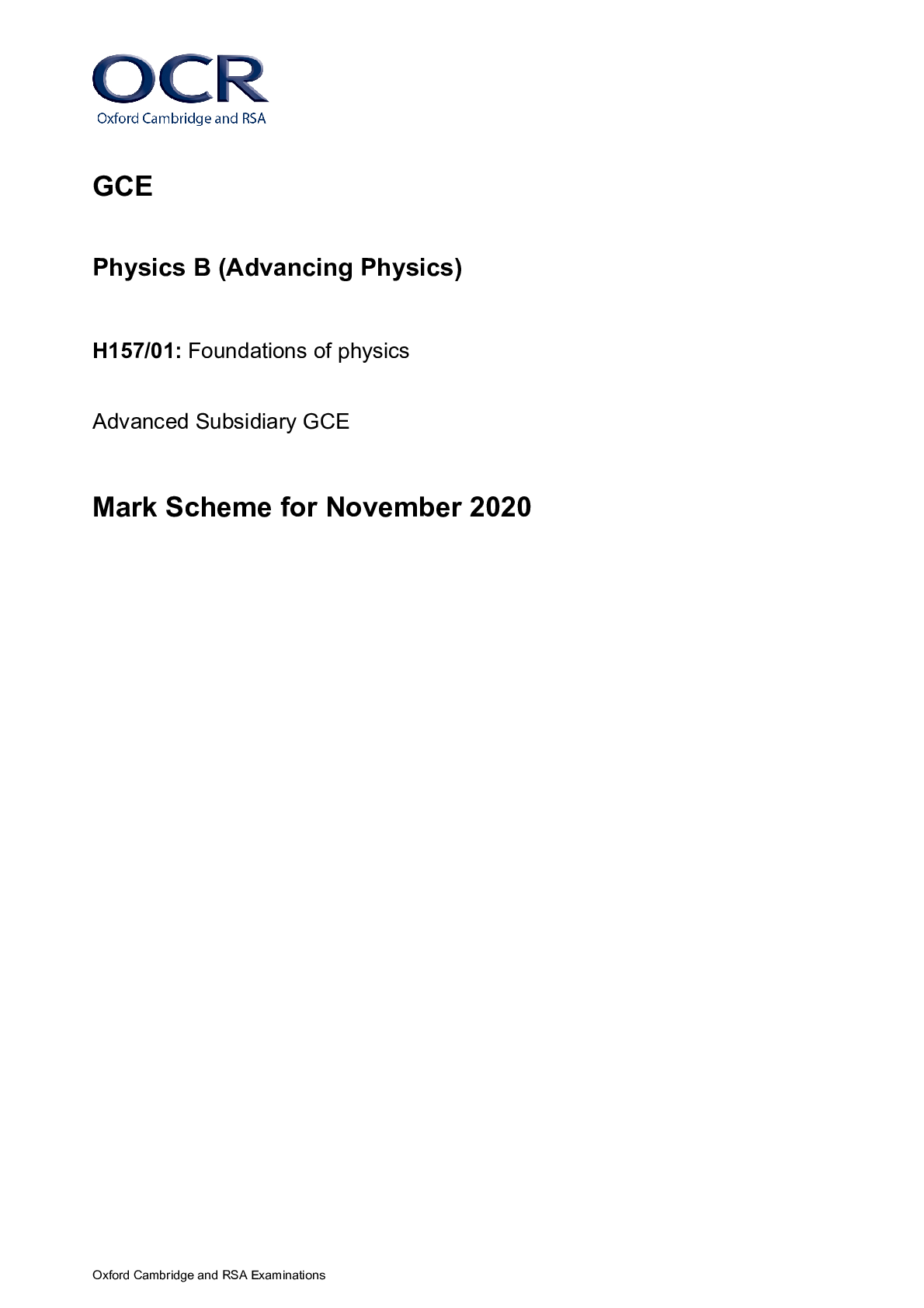Classical Civilisation > AS Mark Scheme > GCE Classical Civilisation H408/23: Invention of the barbarian Advanced GCE Mark Scheme for November (All)
GCE Classical Civilisation H408/23: Invention of the barbarian Advanced GCE Mark Scheme for November 2020
Document Content and Description Below
Oxford Cambridge and RSA Examinations GCE Classical Civilisation H408/23: Invention of the barbarian Advanced GCE Mark Scheme for November 2020Oxford Cambridge and RSA Examinations OCR (Oxford C... ambridge and RSA) is a leading UK awarding body, providing a wide range of qualifications to meet the needs of candidates of all ages and abilities. OCR qualifications include AS/A Levels, Diplomas, GCSEs, Cambridge Nationals, Cambridge Technicals, Functional Skills, Key Skills, Entry Level qualifications, NVQs and vocational qualifications in areas such as IT, business, languages, teaching/training, administration and secretarial skills. It is also responsible for developing new specifications to meet national requirements and the needs of students and teachers. OCR is a not-for-profit organisation; any surplus made is invested back into the establishment to help towards the development of qualifications and support, which keep pace with the changing needs of today’s society. This mark scheme is published as an aid to teachers and students, to indicate the requirements of the examination. It shows the basis on which marks were awarded by examiners. It does not indicate the details of the discussions which took place at an examiners’ meeting before marking commenced. All examiners are instructed that alternative correct answers and unexpected approaches in candidates’ scripts must be given marks that fairly reflect the relevant knowledge and skills demonstrated. Mark schemes should be read in conjunction with the published question papers and the report on the examination. © OCR 2020H408/23 Mark Scheme November 2020 2 Annotations Symbol Description Comment Tick worthy of credit ? unclear S error of spelling E error of grammar, punctuation or expression F error of fact ^ omission H Line to draw an attention to an error V Wavy Line to draw attention to something H Wavy Line to draw attention to something ……… Highlight as directed by PE REL irrelevant pointH408/23 Mark Scheme November 2020 3 REP conspicuous repetition L illegible word or phrase BP Blank Page – this annotation must be used on all blank pages within an answer booklet and on each page of an additional object where there is no candidate response. SUBJECT–SPECIFIC MARKING INSTRUCTIONS Introduction Your first task as an Examiner is to become thoroughly familiar with the material on which the examination depends. You should ensure that you have copies of these materials: ● the specification, especially the assessment objectives ● the question paper and its rubrics ● the mark scheme. You should ensure also that you are familiar with the administrative procedures related to the marking process. These are set out in the OCR booklet Instructions for Examiners. If you are examining for the first time, please read carefully Appendix 5 Introduction to Script Marking: Notes for New Examiners. Please ask for help or guidance whenever you need it. Your first point of contact is your Team Leader. Information and instructions for examiners The co-ordination scripts provide you with examples of the standard of each band. The marks awarded for these scripts will have been agreed by the Team Leaders and will be discussed fully at the Examiners’ Co-ordination Meeting. The specific task-related indicative content for each question will help you to understand how the band descriptors may be applied. However, this indicative content does not constitute the mark scheme: it is material that candidates might use, grouped according to each assessment objective tested by the question. It is hoped that candidates will respond to questions in a variety of ways. Rigid demands for ‘what must be a good answer’ would lead to a distorted assessment. Candidates’ answers must be relevant to the question. Beware of prepared answers that do not show the candidate’s thought and which have not been adapted to the thrust of the question. Beware also of answers where candidates attempt to reproduce interpretations and concepts that they have been taught but have only partially understood.H408/23 Mark Scheme November 2020 4 Using the Mark Scheme Please study this Mark Scheme carefully. The Mark Scheme is an integral part of the process that begins with the setting of the question paper and ends with the awarding of grades. Question papers and Mark Schemes are developed in association with each other so that issues of differentiation and positive achievement can be addressed from the very start. This Mark Scheme is a working document; it is not exhaustive; it does not provide ‘correct’ answers. The Mark Scheme can only provide ‘best guesses’ about how the question will work out, and it is subject to revision after we have looked at a wide range of scripts. The Examiners’ Standardisation Meeting will ensure that the Mark Scheme covers the range of candidates’ responses to the questions, and that all Examiners understand and apply the Mark Scheme in the same way. The Mark Scheme will be discussed and amended at the meeting, and administrative procedures will be confirmed. Co-ordination scripts will be issued at the meeting to exemplify aspects of candidates’ responses and achievements; the co-ordination scripts then become part of this Mark Scheme. Before the Standardisation Meeting, you should read and mark in pencil a number of scripts, in order to gain an impression of the range of responses and achievement that may be expected. Please read carefully all the scripts in your allocation and make every effort to look positively for achievement throughout the ability range. Always be prepared to use the full range of marks. Information and instructions for examiners The co-ordination scripts provide you with examples of the standard of each band. The marks awarded for these scripts will have been agreed by the Team Leaders and will be discussed fully at the Examiners’ Co-ordination Meeting. The specific task-related indicative content for each question will help you to understand how the band descriptors may be applied. However, this indicative content does not constitute the mark scheme: it is material that candidates might use, grouped according to each assessment objective tested by the question. It is hoped that candidates will respond to questions in a variety of ways. Rigid demands for ‘what must be a good answer’ would lead to a distorted assessment. Candidates’ answers must be relevant to the question. Beware of prepared answers that do not show the candidate’s thought and which have not been adapted to the thrust of the question. Beware also of answers where candidates attempt to reproduce interpretations and concepts that they have been taught but have only partially understood. ASSESSMENT OBJECTIVES Candidates are expected to demonstrate the following in the context of the content described for the individual unit: AO1 Demonstrate knowledge and understanding of:H408/23 Mark Scheme November 2020 5 ● literature, visual/material culture and classical thought ● how sources and ideas reflect, and influence, their cultural contexts ● possible interpretations of sources, perspectives and ideas by different audiences and individuals. AO2 Critically analyse, interpret and evaluate literature, visual/material culture, and classical thoughts, using evidence to make substantiated judgements and produce coherent and reasoned arguments. Individual questions are designed to allow the distribution of marks between the Assessment Objectives. For some points based marking and the levels of response questions you are required to identify a candidate’s performance under each assessment objective and award marks accordingly. Marking Scripts Answers must be marked using the level descriptors in the marking grids and a mark awarded for each Assessment Objective. The points in the mark scheme are indicative content only and offer some question specific guidance. Credit should be given for other points and different views, if they seem possible and are well argued or supported by good evidence. You must avoid negative marking - don’t deduct marks for individual errors. All marks should be allocated by reference to the assessment grid. Any queries on unexpected answers please consult your Principal Examiner. Using annotations ● Take great care to place a tick (see below) against any valid points that lead you to think at all favourably of the answer. ● Do not leave any page unmarked (as a last resort tick the very bottom of a page to indicate that you have read it - otherwise Team Leaders/Principal Examiners cannot tell whether account has been taken of that page). ● Underline errors and place the appropriate symbol in the margin. ● Indicate that you have looked at every page of the answer booklet by placing the BP symbol at the top and bottom of any blank pages. Ticks: these are the simplest, quickest and most efficient means for examiners to convey approval to Senior Examiners, and they should be inserted where they can be most effective. If the point you wish to highlight is in the middle of a paragraph, then put the tick in the middle of a line in the middle of a paragraph. Overuse of the tick tends to devalue its effectiveness. Do use ticks to draw attention to anything worthy of credit [even single words]. Do not use ticks as a substitute for marking/assessment; marks for questions must be determined by reference to the assessment grid, NOT by mechanical addition of ticks. Highlighting: use highlighting as directed by your Principal Examiner.H408/23 Mark Scheme November 2020 6 QUALITY OF WRITTEN COMMUNICATION ● Reasonable but not excessive account should be taken of particularly poor spelling (S), punctuation, and other defects in English grammar and expression (E). ● Legibility: use the sign (L) in the margin to areas of a script which you cannot read. ● Extreme cases of illegibility should be referred to your Principal Examiner.H408/23 Mark Scheme November 2020 7 Question Indicative Content Marks Guidance Section A Q1 Source A depicts a battle between two sides. Who is fighting whom? Answers may include: ● Greeks. (1) ● Amazons. (1) Maximum of 2 marks. 2 (AO1) All legitimate answers should be credited. Q2 Explain how the portrayal of the two sides in Source A demonstrates the way the Greeks viewed themselves as different from others. Examples might include: ● Physical superiority of Greeks. (AO2) o Heroic nudity of Greek figures. (AO1) ● Military skills/strength of Greeks. (AO2) o Victory over the Amazons. (AO1) ● Inferiority of Amazons. (AO2) o Defeated in battle. (AO1) ● Dissolute behaviour of Amazons. (AO2) o Shown by state of undress. (AO1) ● Comparison of Greek/male virtues with barbarian/female weakness. (AO2) o Figure shown pulling Amazon’s hair. (AO1) 5 (AO1) 5 (AO2) AO1 marks are awarded for the selection of material from the source. AO2 marks for the interpretation, analysis and evaluation of this outlined in the Levels of Response grid. The indicative content is a description of possible content. All legitimate answers and approaches must be credited appropriately. Q3 Name the city where the play in Source B is set. Answers may include: ● Corinth. (1) 1 (AO1) All legitimate answers should be credited. Q4 ‘What help you gave me’ (line 1). Give two ways that Medea claimed to have ‘helped’ Jason in Source B. 2 (AO1) All legitimate answers should be credited.H408/23 Mark Scheme November 2020 8 Answers may include: ● Locating the golden fleece. (1) ● Putting the dragon to sleep. (1) ● Escaping from Colchis. (1) ● Killing her brother to aid the escape. (1) Potential answers: Saved Jason’s life when he met the fire-breathing bulls. (1) Assisted when he sowed the teeth in the field. (1) Killed the serpent/dragon that guarded the Fleece. (1) Escaping from Colchis. (1) Killed Pelias to aid the escape. (1) Maximum of 2 marks. Q5 Explain how Euripides portrays the advantages of Greek civilisation in Source B. Examples might include: ● Legal code. (AO2) o ‘know what justice means’. (AO1) o ‘benefits of Law’. (AO1) o ‘not rule of force’. (AO1) ● Fame. (AO2) o ‘All Greece has come to know your talents’. (AO1) o ‘You are famous’. (AO1) o ‘… no one would mention you’. o Preferable to ‘gold’ or to ‘sing better than Orpheus’. ● Centre of the world. (AO2) o Medea used to live ‘at the end of the world’. (AO1) … o … in a ‘primitive’ country. (AO1) o Medea ‘gained more than she gave’ despite murdering members of her own family and being exiled. (AO1) … o … plus her personal sacrifice to Jason and her gift of two sons. (AO1) 5 (AO1) 5 (AO2) AO1 marks are awarded for the selection of material from the source. AO2 marks for the interpretation, analysis and evaluation of this outlined in the Levels of Response grid. The indicative content is a description of possible content. All legitimate answers and approaches must be credited appropriately.H408/23 Mark Scheme November 2020 9 Q6 Evaluate the ways in which the Greeks considered themselves superior to barbarians. You may use Sources A and/or Source B as a starting point in your answer. You should use both written and visual sources in your answer. AO1 Candidates might show knowledge and understanding of: Source A ● Heroic nudity of the Greeks. ● Portrayal of victory over barbarians. ● Myth emphasises the Greeks’ ‘natural’ or ‘historic’ superiority. ● Portrayal of Amazons as defeated. ● Portrayal of barbarians as women. Source B ● Suggestion that Medea should be grateful for being in Corinth. ● Colchis described as ‘primitive’ and at ‘the end of the world’. ● Fame (kleos) only possible in Greece. ● Greece enjoys ‘the benefits of law’. ● Non-Greeks have ‘the rule of force’. Literary sources used might include: ● Herodotus ● Aeschylus ● Euripides. Visual/material culture sources used might include: ● Vase painting ● Architectural sculpture/sculpture ● Architecture. AO2 Candidates may demonstrate evaluation and analysis through the use of some of the following arguments: ● Military prowess ● Moral virtue ● Systems of government/the rule of law ● Freedom 10 (AO1) 10 (AO2) The indicative content is a description of possible content only; all legitimate answers and approaches must be credited appropriately. Assess using the marking grids for the 20-mark extended response. Whilst candidates may use the provided source as a starting point, they should not be penalised if they offer a full and detailed response which does not do so.H408/23 Mark Scheme November 2020 10 ● Links to the gods ● Dress ● Diet ● Arts & culture. Section B Question Indicative Content Marks Guidance Q7* ‘Herodotus’ portrayal of the Persians is entirely incorrect.’ Explain how far you agree with this statement and justify your response. AO1 Candidates might show knowledge and understanding of: Herodotus’ description of: ● Characteristics of the Persians. ● Characterisation of Xerxes, including his tyrannical and quasi-godlike behaviour. ● Supernatural events and oracles. ● Herodotus’ narrative and literary devices. Other sources’ descriptions of the Persians, such as: ● Aeschylus ● Persian self-representation in the visual sources AO2 Candidates may demonstrate evaluation and analysis through the use of some of the following arguments: ● Overall historical narrative broadly correct. ● Many accurate details in the text (dress, weapons, tactics, descriptions of aspects of Persia). ● Many inaccurate details in the text (speeches, characterisation of figures Herodotus never met, exaggerations for effect (e.g. use of whips, barbaric behaviour, natural and unnatural events). ● The comparison of Herodotus’ views with those of other sources and historical evidence. 10 (AO1) 20 (AO2) The indicative content is a description of possible content only; all legitimate answers and approaches must be credited appropriately. Assess using the marking grids for the 30-mark extended response. Learners are expected to make use of scholarly views, academic approaches and sources to support their argument; the approach to crediting this is outlined in the Levels of Response Grid.H408/23 Mark Scheme November 2020 11 Q8* ‘In The Persians, Aeschylus tells us more about the Greek world than about the Persian world.’ Explain how far you agree with this statement and justify your response. AO1 Candidates might show knowledge and understanding of: ● The audience. ● The actors. ● Likelihood of Aeschylus’ personal involvement at Salamis. ● Setting and names of characters shows lack of knowledge of Persian court life. ● Description of the battle of Salamis. AO2 Candidates may demonstrate evaluation and analysis through the use of some of the following arguments: ● Illustrates the impact of the Persian defeat. ● Differing interpretations of how the play gives evidence of the character of the Greek audience (e.g. triumphalism/mourning/shared grief). ● Raising of Darius’ ghost typical of Greek beliefs about the Persians. ● Importance of character of Atossa as evidence of Greek views on role of the sexes in Persia, compared to Greece. ● Characterisation of Persian monarchy. ● Darius’ attribution of blame suggests Persians have broken natural laws (which by implication the Greeks abide by). ● Hubris. 10 (AO1) 20 (AO2) The indicative content is a description of possible content only; all legitimate answers and approaches must be credited appropriately. Assess using the marking grids for the 30-mark extended response. Learners are expected to make use of scholarly views, academic approaches and sources to support their argument; the approach to crediting this is outlined in the Levels of Response Grid.H408/23 Mark Scheme November 2020 12 Guidance on applying the marking grids for the 10-mark stimulus question Two Assessment Objectives are being assessed in this question: AO1 and AO2.The two Assessment Objectives are equally weighted. Examiners must use a best fit approach to the marking grid. Where there are both strengths and weaknesses in a particular response, particularly imbalanced responses in terms of the assessment objectives, examiners should carefully consider which level is the best fit for the performance overall. For example, you should not be able to achieve a mark of 8 made up of AO1 = 6 and AO2 = 2 When using this grid: ● Determine the level: start at the highest level and work down until you reach the level that matches the answer ● Determine the mark within the level: consider whether the response consistently meets the criteria for the level, and/or could be described as closer to the level above or the one below ● Marks for questions must be determined by reference to the assessment grid, NOT by mechanical addition of ticks. Level Marks Characteristics of Performance 5 9–10 AO1: Shows very good knowledge and understanding of the provided source/ideas through a range of well selected, accurate and precise material from it AO2: Fully and consistently engages with the question, with perceptive, critical analysis and interpretation of the provided source leading to convincing points which are well-supported and developed 4 7–8 AO1: Shows good knowledge and understanding of the provided source/ideas through a range of well selected, mostly accurate, material from it AO2: Engages clearly and directly with the question, with critical analysis and interpretation of the provided source leading to sound points, which are supported and developed 3 5–6 AO1: Shows reasonable knowledge and understanding of the provided source/ideas through use of a range of mostly accurate material from it AO2: Engages with some of the fundamental issues of the question, with analysis and interpretation of the provided source leading to some tenable points, which have some support and development 2 3–4 AO1: Shows basic knowledge and understanding of the provided source/ideas through use of some material from it with some degree of accuracy AO2: Engages with the general topic of the question, with little analysis and interpretation of the provided source leading to weak points, which have occasional support and development 1 1–2 AO1: Shows limited knowledge and understanding of the provided source/ideas through little use of accurate material from it AO2: Limited and very simplistic attempt to engage with the topic of the question, with very little analysis and interpretation of the provided source leading to points of little relevance 0 0 No response worthy of creditH408/23 Mark Scheme November 2020 13 Guidance on applying the marking grids for the 20-mark extended response Two Assessment Objectives are being assessed in this question: AO1 and AO2.The two Assessment Objectives are equally weighted. Examiners must use a best fit approach to the marking grid. Where there are both strengths and weaknesses in a particular response examiners should carefully consider which level is the best fit for the performance overall. Note that candidates can achieve different levels in each assessment objective, for example a Level 3 for AO1, and a Level 2 for AO2. When using this grid: ● Determine the level: start at the highest level and work down until you reach the level that matches the answer ● Determine the mark within the level: consider whether the response consistently meets the criteria for the level, and/or could be described as closer to the level above or the one below AO1 AO2 Level Marks Characteristics of Performance Level Marks Characteristics of Performance 5 9 – 10 ● very detailed knowledge and a thorough understanding of the material studied ● use of a range of well selected, accurate and precise material from classical sources and/or classical ideas; and appropriate, effective use of their cultural context and possible interpretation 5 9 – 10 ● a very good response to the question containing a wide range of relevant points leading to convincing conclusions ● points are very well supported by perceptive critical analysis, interpretation and evaluation of classical sources and/or classical ideas the response is logically structured, with a well-developed, sustained and coherent line of reasoning 4 7 – 8 ● detailed knowledge and a sound understanding of the material studied ● use of a range of well selected, mostly accurate, material from classical sources and/or classical ideas; and appropriate use of their cultural context and possible interpretation 4 7 – 8 ● a good response to the question containing a range of relevant points leading to appropriate conclusions ● points are consistently supported by critical analysis, interpretation and evaluation of classical sources and/or classical ideas the response is logically structured, with a well-developed and clear line of reasoning 3 5 – 6 ● reasonable knowledge and understanding of the material studied ● use of a range of mostly accurate material from classical sources and/or classical ideas; and some use of their cultural context and possible interpretation 3 5 – 6 ● a reasonable response to the question containing some relevant points leading to tenable conclusions ● points are generally supported by analysis, interpretation and evaluation of classical sources and/or classical ideas the response presents a line of reasoning which is mostly relevant and has some structure 2 3 – 4 ● basic knowledge and understanding of the material studied ● use of a limited range of material from classical sources and/or classical ideas; with some degree of accuracy, and limited use of their cultural context and possible interpretation 2 3 – 4 ● a basic response to the question containing some points, which may be narrow in scope and limited in relevancy, leading to weak conclusions ● points are occasionally supported by analysis, interpretation and evaluation of classical sources and/or classical ideas the response presents a line of reasoning but may lack structureH408/23 Mark Scheme November 2020 14 1 1 – 2 ● limited knowledge and understanding of the material studied ● use of little accurate material from classical sources and/or classical ideas; and little or no use of their cultural context and possible interpretation 1 1 – 2 ● little engagement with the question, any points or conclusions made are of little relevance ● isolated use of classical sources and/or classical ideas with little analysis, interpretation and evaluation the information is communicated in an unstructured way 0 0 ● no response worthy of credit 0 0 ● no response worthy of credit Guidance on applying the marking grids for the 30-mark extended response Two Assessment Objectives are being assessed in this question: AO1 and AO2.The two Assessment Objectives are equally weighted. Examiners must use a best fit approach to the marking grid. Where there are both strengths and weaknesses in a particular response examiners should carefully consider which level is the best fit for the performance overall. Note that candidates can achieve different levels in each assessment objective, for example a Level 3 for AO1, and a Level 2 for AO2. When using this grid: ● Determine the level: start at the highest level and work down until you reach the level that matches the answer ● Determine the mark within the level: consider whether the response consistently meets the criteria for the level, and/or could be described as closer to the level above or the one below AO1 AO2 Level Marks Characteristics of Performance Level Marks Characteristics of Performance 5 9 – 10 ● very detailed knowledge and a thorough understanding of the material studied ● use of a range of well selected, accurate and precise material from classical sources and/or classical ideas; and appropriate, effective use of their cultural context and possible interpretation 5 17 – 20 ● a very good response to the question containing a wide range of relevant points leading to convincing conclusions ● points are very well supported by critical perceptive analysis, interpretation and evaluation of classical sources and/or classical ideas and secondary sources, scholars and/or academic works the response is logically structured, with a well-developed, sustained and coherent line of reasoning 4 7 – 8 ● detailed knowledge and a sound understanding of the material studied ● use of a range of well selected, mostly accurate, material from classical sources and/or classical ideas; and appropriate use of their cultural context and possible interpretation 4 13 – 16 ● a good response to the question containing a range of relevant points leading to appropriate conclusions ● points are consistently supported by critical analysis, interpretation and evaluation of classical sources and/or classical ideas and secondary sources, scholars and/or academic works the response is logically structured, with a well-developed and clear line of reasoning 3 5 – 6 ● reasonable knowledge and understanding of the material studied 3 9 – 12 ● a reasonable response to the question containing some relevant points leading to tenable conclusionsH408/23 Mark Scheme November 2020 15 ● use of a range of mostly accurate material from classical sources and/or classical ideas; and some use of their cultural context and possible interpretation ● points are generally supported by analysis, interpretation and evaluation of classical sources and/or classical ideas and there is some use of secondary sources scholars and/or academic works the response presents a line of reasoning which is mostly relevant and has some structure 2 3 – 4 ● basic knowledge and understanding of the material studied ● use of a limited range of material from classical sources and/or classical ideas, with some degree of accuracy, and limited use of their cultural context and possible interpretation 2 5 – 8 ● a basic response to the question containing some points, which may be narrow in scope and limited in relevancy, leading to weak conclusions ● points are occasionally supported by analysis, interpretation and evaluation of classical sources and/or classical ideas, and there is little or no use of secondary sources, scholars and/or academic works the response presents a line of reasoning but may lack structure 1 1 – 2 ● limited knowledge and understanding of the material studied ● use of little accurate material from classical sources and/or classical ideas, and little or no use of their cultural context and possible interpretation 1 1 – 4 ● little engagement with the question and any points or conclusions made are of little or no relevance ● isolated use of classical sources and/or classical ideas, with little analysis, interpretation and evaluation the information is communicated in an unstructured way 0 0 ● no response worthy of credit 0 0 ● no response worthy of creditOCR (Oxford Cambridge and RSA Examinations) The Triangle Building Shaftesbury Road Cambridge CB2 8EA [Show More]
Last updated: 1 year ago
Preview 1 out of 17 pages

Buy this document to get the full access instantly
Instant Download Access after purchase
Add to cartInstant download
We Accept:

Reviews( 0 )
$7.50
Document information
Connected school, study & course
About the document
Uploaded On
Oct 10, 2022
Number of pages
17
Written in
Additional information
This document has been written for:
Uploaded
Oct 10, 2022
Downloads
0
Views
52

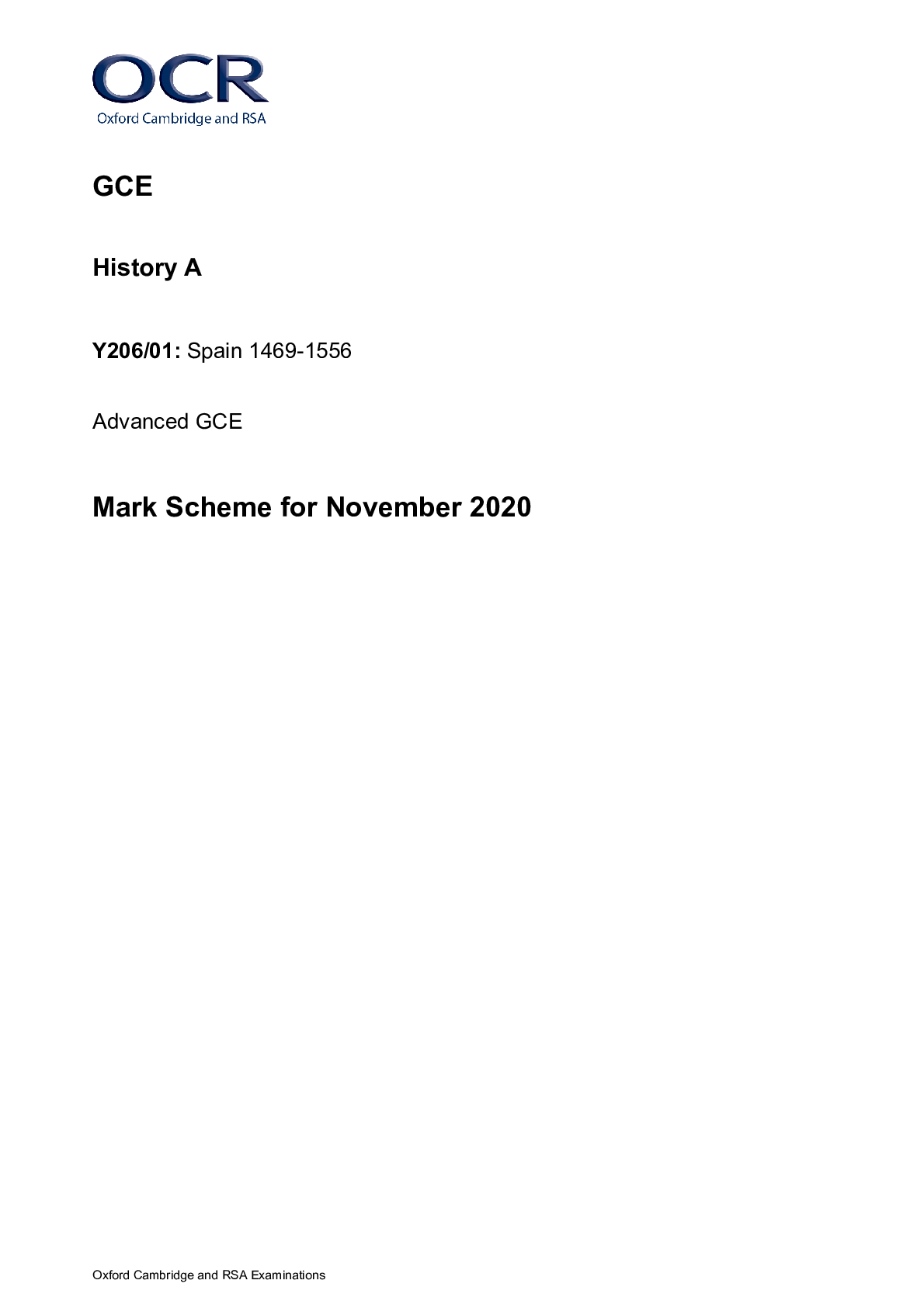
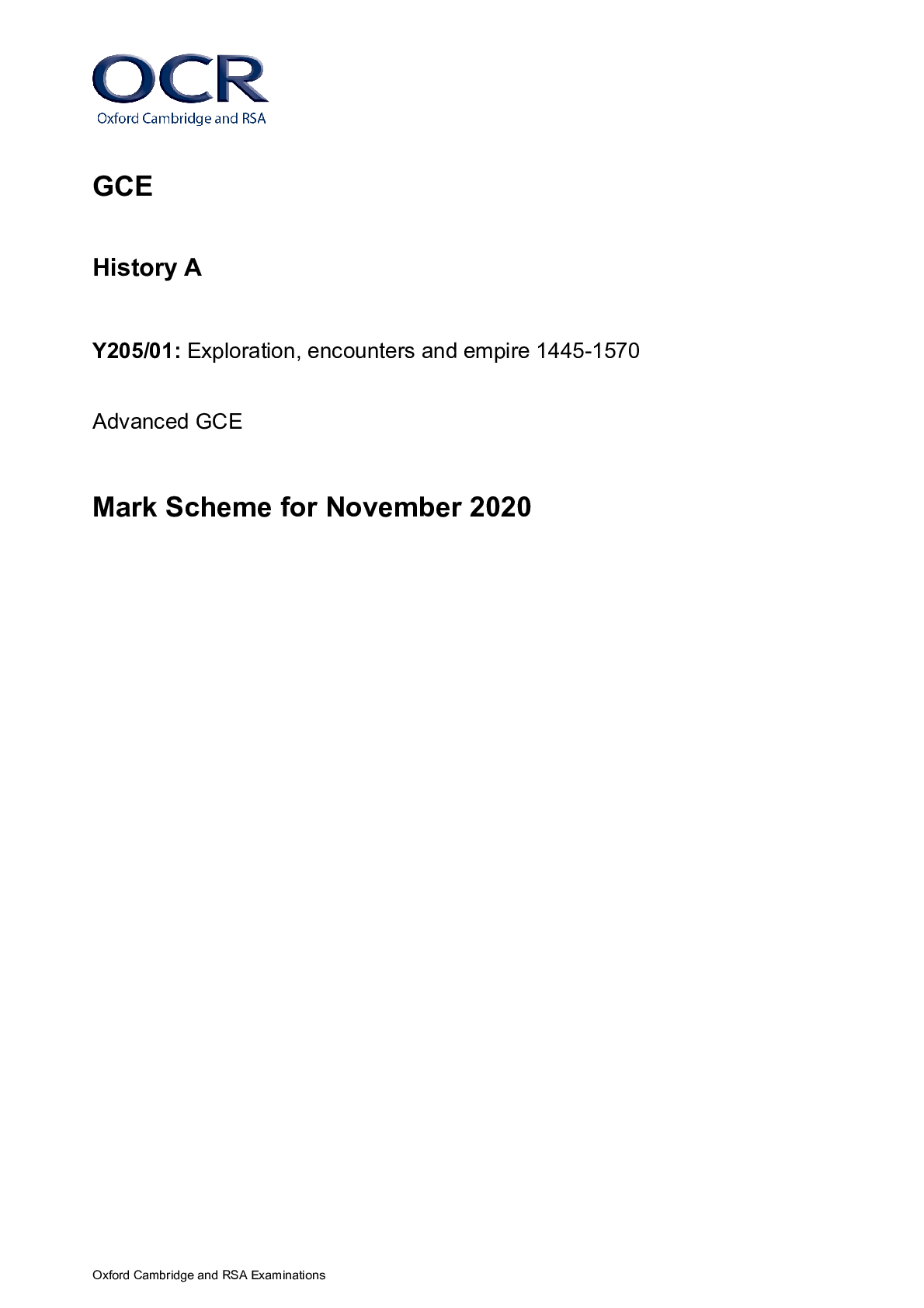






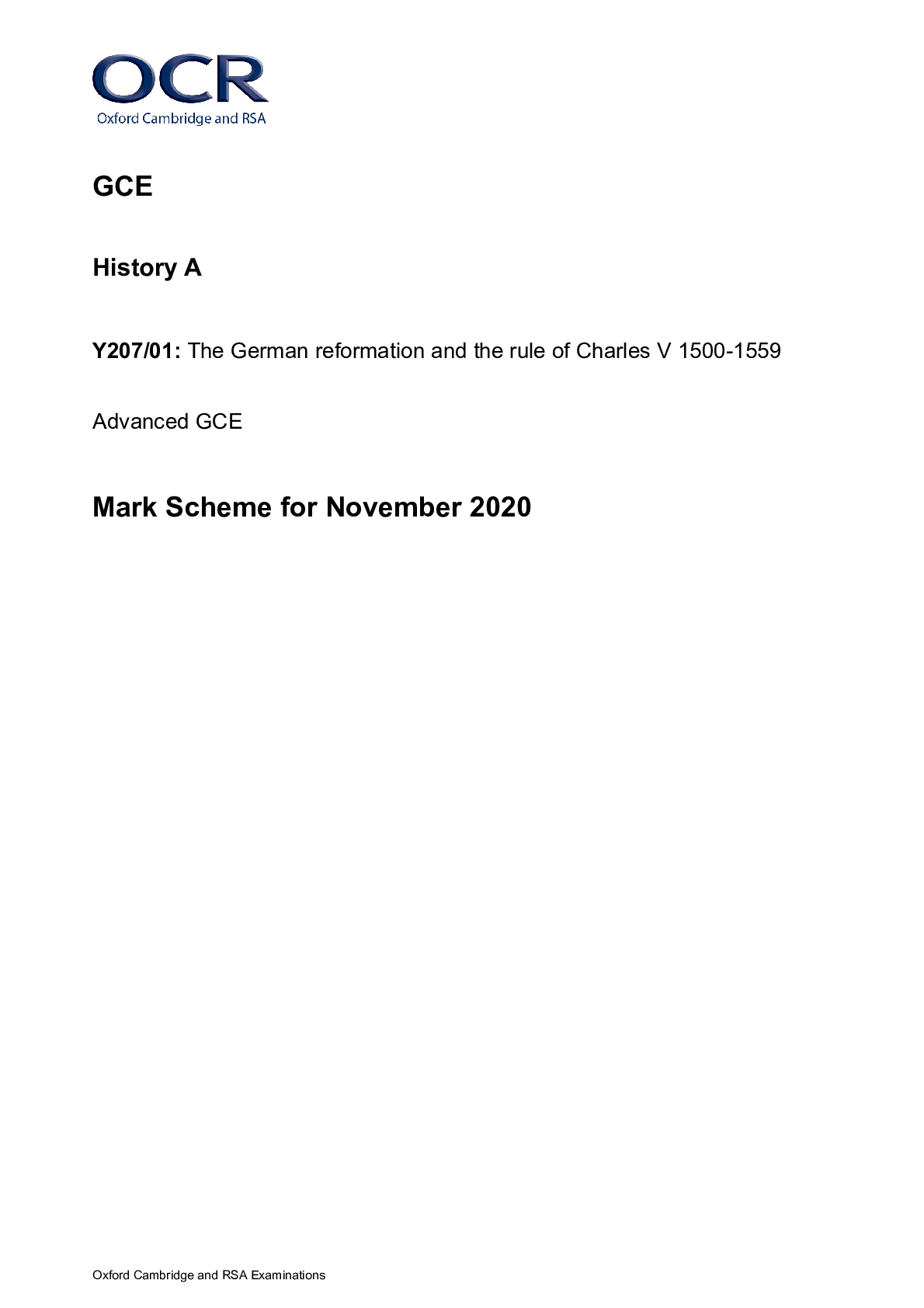





.png)

